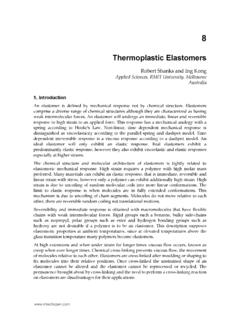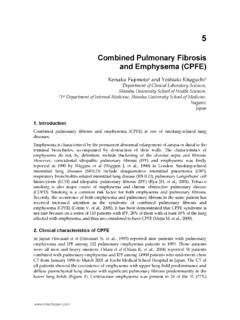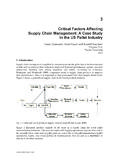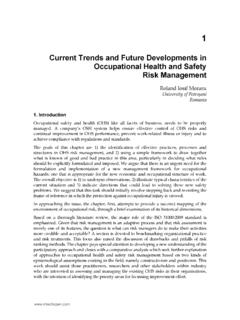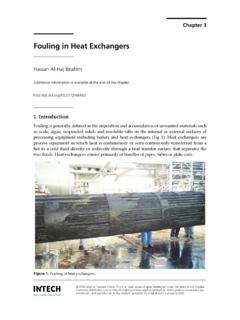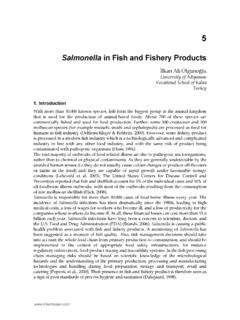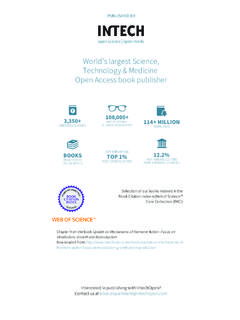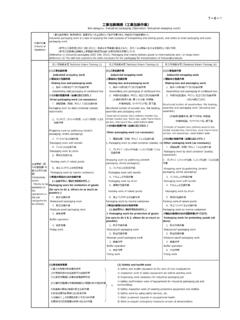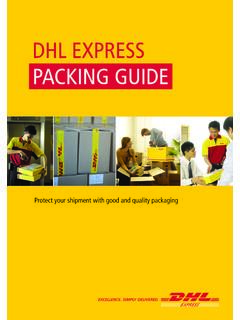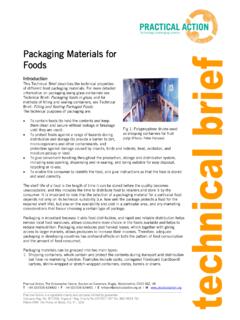Transcription of Polypropylene in the Industry of Food Packaging
1 1 Polypropylene in the Industry of Food Packaging Somaye Allahvaisi Department of Entomology and Toxicology, Faculty of Agriculture, Islamic Azad University of Tehran, Branch of Sciences & Researches, Iran 1. Introduction Various pests expose agriculture and food products to attack from storage until consumption by consumers. Insects and fungi are the most serious pests that can contaminate food products in warehouses. Despite modern food and other agricultural products storage and distribution systems, most packaged food products, with the exception of canned and frozen goods, are subject to attack and penetration by insects (Mullen & Highland, 1988). When a Packaging containing one of insect life stages enters into storages (infested Packaging ), it could cause the prevalence of infestation.
2 In addition to reducing food quantity, insects annihilate quality, too. By nourishing into the foods, they prepare the conditions for the attack by pathogen microorganisms, such as fungi and as such, the consumption of these foodstuffs could be followed by dangerous present day diseases cancer types as contaminated foods to pathogens like fungi are one of the most important problems in the Industry of storage foods and they are susceptible to mycotoxins (Jakic-Dimic et al., 2009). There are few categories of mycotoxins regarding their chemical structure, sensitivity of certain organs and origin of fungi that produce them. Aflatoxin is a secondary metabolite produced by Aspergillus flavus (Lopez-Diaz &Flannigan, 1997). Aflatoxin is potential to cause liver damage, cirrhosis, and liver cancer and aflatoxin B1 is the most dangerous toxin for animal and human health (Syarief et al.)
3 , 2003). So, huge losses have been observed in agriculture produce and different ways are designed for controlling stored-product pests. Storing foodstuffs in bulk or sacks is a usual method for controlling pests without application of chemical methods. These sacks are made of different materials such as sheeted polymers used for Packaging agricultural products to prevent the entrance of pests and contaminations (Allahvaisi, 2009). Wastage varies from 5-35% depending on nature of crops. Majority of wastage takes place in each of the steps viz. storage, transportation and at retail market due to improper Packaging . Bulk Packaging made of polymers provides a solution for commodities weighing 10-50 kg during handling, storage and transportation, while smaller Packaging for food products range from 50 ml to 5kg.
4 Polymeric Packaging fulfils the diverse role from protecting products, preventing spoilage, contamination, extending shelf life, ensuring safe storage thereby helping to make them readily available to consumers in our day to day life. This chapter will be a very helpful to Polypropylene 4 all its readers, entrepreneurs, scientists, existing industries, technical institution, etc in the field of Packaging (Anonymous, 2011). 2. Why plastics for packing? Today, several polymer types are currently used for foodstuff Packaging . Plastics have emerged as the most preferred choice of Packaging materials for various products- from food, beverages, chemicals, electronic items and so on. They offer unique advantages over conventional materials (Anonymous, 2011): Safety: Plastics are safer materials for Packaging of food products specially polyolefins which do not react with food.
5 Pilferage and contamination is difficult. Shelf Life: Plastics Packaging material offer better shelf life Cost: Plastics are the most cost effective medium of Packaging when compared with any other material, the cost of transportation is reduced considerable on account of lower weight and less damage Convenience: Plastics can be converted in any form with various processing techniques, thus can pack any type of substances like liquids, powders, flakes, granules, solids. Waste: Packaging in plastics reduces the wastage of various food products, typical example is potatoes or onions packed in leno. Aesthetics: A right choice of plastics Packaging increased the aesthetic value of products and helps in brand identity Handling and Storage: Products packed in plastics are easiest to handle and store as well as transport.
6 Plastic products are easy to recycle. Every day there are new products packed in plastics replacing conventional products and when a thought is given to pack a new product the first choice appears in the mind is Plastic Packaging material. 3. Flexible plastic films In general, flexible plastic films have relatively low cost and good barrier properties against moisture and gases; they are heat sealable to prevent leakage of contents; they add little weight to the product and they fit closely to the shape of the food, thereby wasting little space during storage and distribution; they have wet and dry strength, and they are easy to handle and convenient for the manufacturer, retailer and consumer. The main disadvantages are that (except cellulose) they are produced from non-renewable oil reserves and are not biodegradable. Concern over the environmental effects of non-biodegradable oil-based plastic Packaging materials has increased research into the development of bioplastics that are derived from renewable sources, and are biodegradable (Stewart, 1995).
7 However, these materials are not yet available commercially in developing countries. There is a very wide choice of plastic films made from different types of plastic polymer. Each can have ranges of mechanical, optical, thermal and moisture/gas barrier properties. These are produced by variations in film thickness and the amount and type of additives that are used in their production. Some films ( polyester, polyethylene, Polypropylene ) can be oriented by stretching the Polypropylene in the Industry of Food Packaging 5 material to align the molecules in either one direction (uniaxial orientation) or two (biaxial orientation) to increase their strength, clarity, flexibility and moisture/gas barrier properties. There are thus a very large number of plastic films and small-scale processors should obtain professional advice when selecting a material to ensure that it is suitable for the intended product and shelf life.
8 Typically, the information required includes: type of plastic polymer(s) required; thickness/strength; moisture and gas permeability; heat seal temperature; printability on one or both sides; and suitability for use on the intended filling machinery (Ramsland, 1989; Robertson, 1993). Some may offer virtually no resistance against insects while others may be extremely resistant (Highland, 1981). Plastics based on Polypropylene (PP), polyethylene (PE), Polyvinylchloride (PVC) and Cellophane is mainly used for Packaging applications (Table 1) (Odian, 2004). Properties Polyethylene PolypropylenePolyvinyl chloride Cellophane Max. heat tolerance ( C) 82-93 132-149 66-93 90-140 Min. heat tolerance ( C) -57 -18 -46 to -29 -77 Sun light resistance Moderate to good moderate good good Gas transmission (mm/100 cm2 in 24 h and 25 C) O2 500 160 8-160 122-480 N2 180 20 1-70 33-90 CO2 2700 540 20-1900 2220 H2O Absorption % < < 0 < H2O Vapor transmission (g/100 cm2 in 24h & C & 90%) 4-10 Table 1.
9 Some properties of used different polymers for Packaging foodstuffs A summary of the main different types of flexible plastic films is as follows (Anonymous, 2008): Cellulose Plain cellulose is a glossy transparent film that is odourless, tasteless and biodegradable (within approximately 100 days). It is tough and puncture resistant, although it tears easily. It has dead-folding properties that make it suitable for twist- wrapping ( sugar confectionery). However, it is not heat sealable and the dimensions and permeability of the film vary with changes in humidity. It is used for foods that do not require a complete moisture or gas barrier, including fresh bread and some types of sugar confectionery. Cellulose acetate is a clear, glossy transparent, sparkling film that is permeable to water vapour, odours and gases and is mainly used as a window material for paperboard cartons (Chiellini, 2008).
10 Polyethylene (or polythene) Low-density polyethylene (LDPE) is heat sealable, inert, odour free and shrinks when heated. It is a good moisture barrier but is relatively permeable to oxygen and is a poor Polypropylene 6 odour barrier. It is less expensive than most films and is therefore widely used for bags, for coating papers or boards and as a component in laminates. LDPE is also used for shrink - or stretch - wrapping (see Technical Brief: Filling and Sealing Packaged Foods). stretch - wrapping uses thinner LDPE (25 - 38 m) than shrink - wrapping (45-75 m), or alternatively, linear low-density polyethylene is used at thicknesses of 17 - 24 m. The cling properties of both films are adjusted to increase adhesion between layers of the film and to reduce adhesion between adjacent packages (Fellows & Axtell, 2003). High-density polyethylene (HDPE) is stronger, thicker, less flexible and more brittle than LDPE and a better barrier to gases and moisture.


